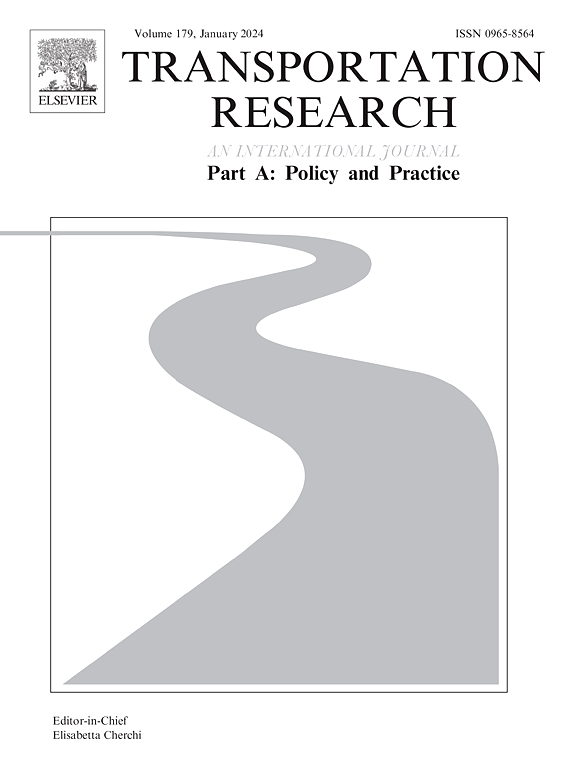Examining the determinants of travel time use and the transfer of activities into trips
IF 6.3
1区 工程技术
Q1 ECONOMICS
Transportation Research Part A-Policy and Practice
Pub Date : 2025-03-27
DOI:10.1016/j.tra.2025.104460
引用次数: 0
Abstract
Travel time use has long been hypothesised to affect behavioural aspects of travel demand, such as mode choice and the value of travel time. However, travel time use can also influence how people organise their daily schedules because travellers can perform activities that release time outside the journey, a behaviour we call “activity transfer” in this study. This research develops a comprehensive conceptual framework to investigate the determinants of travel time use and activity transfer. For that, we utilise a rich dataset of a representative sample (n = 1673) of the Greater Melbourne and Geelong population (Australia) and implement an Integrated Choice Latent Variable (ICLV) model. We model three mutually exclusive behaviours: (1) no engagement in travel time use; (2) travel time use without activity transfer; and (3) travel time use with activity transfer, during a trip towards the individuals’ main activity (e.g., work, study, or other main trip purpose). The ICLV results indicate activity transfer as a time-management strategy for people overlapping different roles and, thus, potentially having more time constraints. Conversely, travel time use without transfer seems to be a strategy for decreasing the dislike of travelling. Activity transfer is more likely to occur in passengerised modes (i.e., public transport and car passenger) with favourable travel conditions (e.g., seat availability) and less likely to occur on short journeys. Bringing laptops with an internet connection to the trip is associated with travel time use with and without activity transfer, while smartphones are predictors only of the latter. Importantly, after controlling for other time-use-related latent constructs, polychronicity becomes a weak predictor of travel time use and activity transfer, suggesting a potential omitted variable bias in previous research. By unveiling fundamental aspects of travel time use, our results have significant implications for transport practice, including public transport investments, long-distance travel modes, and passenger vehicle automation.
求助全文
约1分钟内获得全文
求助全文
来源期刊
CiteScore
13.20
自引率
7.80%
发文量
257
审稿时长
9.8 months
期刊介绍:
Transportation Research: Part A contains papers of general interest in all passenger and freight transportation modes: policy analysis, formulation and evaluation; planning; interaction with the political, socioeconomic and physical environment; design, management and evaluation of transportation systems. Topics are approached from any discipline or perspective: economics, engineering, sociology, psychology, etc. Case studies, survey and expository papers are included, as are articles which contribute to unification of the field, or to an understanding of the comparative aspects of different systems. Papers which assess the scope for technological innovation within a social or political framework are also published. The journal is international, and places equal emphasis on the problems of industrialized and non-industrialized regions.
Part A''s aims and scope are complementary to Transportation Research Part B: Methodological, Part C: Emerging Technologies and Part D: Transport and Environment. Part E: Logistics and Transportation Review. Part F: Traffic Psychology and Behaviour. The complete set forms the most cohesive and comprehensive reference of current research in transportation science.

 求助内容:
求助内容: 应助结果提醒方式:
应助结果提醒方式:


